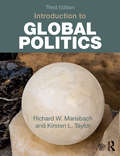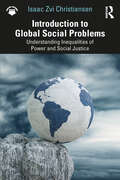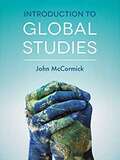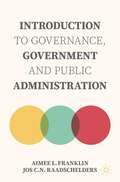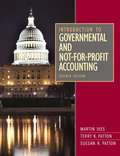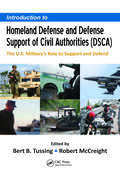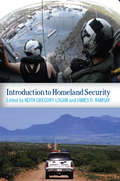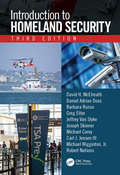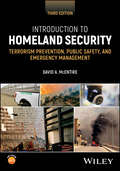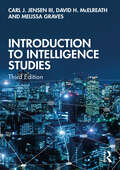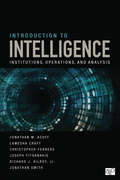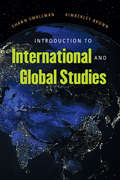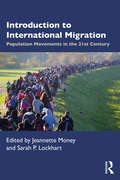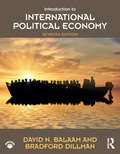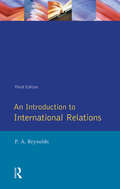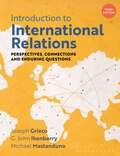- Table View
- List View
Introduction to Global Politics
by Richard W. Mansbach Kirsten L. TaylorThe fully updated third edition of Introduction to Global Politics continues to provide a vital resource for students looking to explain global politics using an historical approach, firmly linking history with the events of today. By integrating theory and political practice at individual, state, and global levels, students are introduced to key developments in global politics, helping them make sense of major trends that are shaping our world. Retaining the successful format of previous editions, this is a highly illustrated textbook with informative and interactive boxed material throughout. Chapter opening timelines contextualize the material that follows, and definitions of key terms are provided in a glossary at the end of the book. Every chapter ends with student activities, cultural materials, and annotated suggestions for further reading. Key updates for this edition: New material on key topical issues such as Islam’s relationship with the West, Islamic State, BRICS and other emerging economies, the continuing effects of the Arab Spring, and R2P. Coverage of the 2015 Iran nuclear deal and North Korea’s continued development of its nuclear weapons and missile programs. Analysis of new technologies for warfighting – such as drones, IEDs and cyber technologies – as well as technologies for countering terrorism and conducting unconventional wars. Updated examples from around the globe in every chapter. Stimulating and provocative both for students and for instructors, Introduction to Global Politics, 3rd Edition, is essential reading for students of political science, global politics, and international relations.
Introduction to Global Social Problems: Understanding Inequalities of Power and Social Justice
by Isaac Zvi ChristiansenIntroduction to Global Social Problems introduces undergraduate students to national and international social problems from a critical sociological perspective. Isaac Zvi Christiansen presents clear descriptions of each social problem, explains key concepts, and provides students with the relevant theoretical tools needed to grasp the interconnected nature of these phenomena.This volume covers significant and interconnected issues. The book begins with an explanation of how corporate interests distort the depiction of social problems. Chapters 2 and 3 provide empirical explorations of poverty and inequality on national and global scales, together with clear and accessible expositions of relevant sociological theories. Chapter 4 examines health and educational inequalities exacerbated by the economic inequalities discussed in Chapters 2 and 3. Chapter 5 introduces students to issues of racial inequalities in the United States and abroad, while Chapter 6 takes a comparative approach to examining crime and criminal justice. Chapter 7 examines modern-day imperialism and war, with special attention given to the military industrial complex, and a brief review of US interventions around the world in the twentieth and twenty-first centuries. Chapter 8 examines politics and human rights, including a critical, historical, and sociological analysis of Israeli settler-colonialism and successive US/Israeli assaults on Gaza. The book closes with an examination of population and the environment, with special attention given to climate change, and the pressing contradictions between capitalism and the environment.This textbook will be a vital resource for introductory students across the social sciences, especially in sociology, political science, and global studies. It provides critical wraparound coverage of the momentous, embedded social problems that interconnect across social, national, and regional boundaries.
Introduction to Global Studies
by John McCormickThis textbook provides a multidisciplinary introduction to Global and International Studies. Offering unrivalled breadth and depth, it covers all the key dimensions of the topic, including broad introductions to international politics and economics, and focused surveys of topics from human rights and migration to conflict and the environment. <p><p>John McCormick’s lucid writing style renders complex information understandable to all students. Full-colour photographs, maps, tables and figures bring the subject to life and innovative pedagogical features emphasize the importance of understanding perspectives and experiences different from one’s own worldview. <p><p>Assuming no prior knowledge of the subject, this textbook is ideal for undergraduate students worldwide who are taking introductory modules in Global and International Studies. The text can also be used by undergraduate students taking courses on Globalization.
Introduction to Global Studies
by John McCormickThe second edition of Introduction to Global Studies offers a succinct and authoritative introduction to the important issues and events of our rapidly changing world. It covers all of the key topics in the field, including introductions to history, culture, science, politics, and economics, alongside focused surveys on pressing global matters such as human rights, migration, the climate emergency, and health and disease. <p><p>With learning features that hone in on key themes and debates, such as Global and Local and North and South boxes, this essential text will help you to navigate challenging issues. Full-color photographs, figures, and maps bring the subject to life. Ideal for students beginning courses on and related to global studies, this second edition offers: <p><p>-A brand new chapter on health and disease, with additional coverage of COVID-19 incorporated throughout the book. <p><p>-Increased coverage of inequality and gender, with a thematic focus on how inequalities are compounded across global society <p><p>-Contemporary Debates: a new feature outlining the pros and cons of controversial topics <p><p>-A comprehensive companion website, offering an array of resources for both students and lecturers, including a test bank, illustrated lecturer slides, interactive quizzes, and an online media library.
Introduction to Governance, Government and Public Administration
by Aimee L. Franklin Jos C.N. RaadscheldersThis undergraduate textbook introduces students to the subjects of public administration, government and governance. It provides an accessible and informative overview of the various substantive areas that comprise the study of public administration, drawing on examples and case studies from around the world. The opening chapters outline some of the basics of the political-administrative institutional arrangements for governing. The following chapters introduce students to the fundamentals of public administration. Study questions, supplemental guidance for instructors, and a glossary of terms will be useful for both students and teachers.
Introduction to Governmental and Not-for-profit Accounting (7th Edition)
by Terry K. Patton Martin Ives Larry A. Johnson Joseph R. Razek Gordon A. Hosch Suesan R. PattonCovering the essentials of fund accounting, this flexible book introduces the reader to the basic accounting principles at work in both governmental and not-for-profit organizations.
Introduction to Homeland Defense and Defense Support of Civil Authorities (DSCA): The U.S. Military's Role to Support and Defend
by Bert B. Tussing Robert McCreightThe application of our Armed Forces within the states and territories of the United States is far from intuitive. The challenges of defending the country against assaults within the homeland are much more complex than engaging our enemies on foreign soil. Likewise, the introduction of the military‘s appreciable capabilities in response to disasters
Introduction to Homeland Security
by Keith Gregory Logan James D. RamsayThis text for students covers the organization, operations, practices, and policies of the Office of Homeland Security, with an emphasis on practical issues. Contributors are academics and practitioners in emergency management, law, information systems, and political science; many work at military educational institutions. Part 1 details the organization and administration of homeland security, and includes a chapter on public and private sector partnerships. Part 2 covers homeland security resources, with material on protection of critical infrastructure, intelligence, support of civil authorities, and technology. Part 3 describes strategies in planning, communication, and counterterrorism. A final chapter sets out foundations of homeland security education. The text includes many b&w photos and images. Logan teaches at Kutztown University. Ramsay teaches at Embry-Riddle Aeronautical University Annotation ©2012 Book News, Inc. , Portland, OR (booknews. com)
Introduction to Homeland Security
by Keith Gregory Logan James D. RamsayThis book introduces students to the dynamic and complex enterprise that is homeland security. Using a broad lens, the authors explore key operational and content areas, as well as the practices and policies that are part of an effective homeland security program. With original essays from academics and practitioners, the book encapsulates the breadth of homeland security as it exists today. Topical coverage includes: administration, intelligence, critical infrastructure protection, emergency management, terrorism and counterterrorism, law and policy, technology and systems, strategic planning, strategic communication, civil-military affairs, private sector involvement, environmental security, and public health. Accessible, engaging, and comprehensive, this is an essential resource for courses on homeland security.
Introduction to Homeland Security
by Keith Gregory Logan James D. RamsayThis book introduces students to the dynamic and complex enterprise that is homeland security. Using a broad lens, the authors explore key operational and content areas, as well as the practices and policies that are part of an effective homeland security program. With original essays from academics and practitioners, the book encapsulates the breadth of homeland security as it exists today. Topical coverage includes: administration, intelligence, critical infrastructure protection, emergency management, terrorism and counterterrorism, law and policy, technology and systems, strategic planning, strategic communication, civil-military affairs, private sector involvement, environmental security, and public health. Accessible, engaging, and comprehensive, this is an essential resource for courses on homeland security.
Introduction to Homeland Security
by Keith Gregory Logan James D. RamsayThis book introduces students to the dynamic and complex enterprise that is homeland security. Using a broad lens, the authors explore key operational and content areas, as well as the practices and policies that are part of an effective homeland security program. With original essays from academics and practitioners, the book encapsulates the breadth of homeland security as it exists today. Topical coverage includes: administration, intelligence, critical infrastructure protection, emergency management, terrorism and counterterrorism, law and policy, technology and systems, strategic planning, strategic communication, civil-military affairs, private sector involvement, environmental security, and public health. Accessible, engaging, and comprehensive, this is an essential resource for courses on homeland security.
Introduction to Homeland Security
by Keith Gregory LoganThis book introduces students to the dynamic and complex enterprise that is homeland security. Using a broad lens, the authors explore key operational and content areas, as well as the practices and policies that are part of an effective homeland security program. With original essays from academics and practitioners, the book encapsulates the breadth of homeland security as it exists today. Topical coverage includes: administration, intelligence, critical infrastructure protection, emergency management, terrorism and counterterrorism, law and policy, technology and systems, strategic planning, strategic communication, civil-military affairs, private sector involvement, environmental security, and public health. Accessible, engaging, and comprehensive, this is an essential resource for courses on homeland security.
Introduction to Homeland Security, Third Edition
by Barbara Russo Robert Nations David H. McElreath Joseph Skinner Daniel Adrian Doss Carl J. Jensen III Greg Etter Jeffrey Van Slyke Michael Corey Michael Wigginton, Jr.Introduction to Homeland Security, Third Edition provides the latest developments in the policy and operations of domestic security efforts of the agencies under the U.S. Department of Homeland Security. This includes the FBI, Secret Service, FEMA, the Coast Guard, TSA and numerous other federal agencies responsible for critical intelligence, emergency response, and the safety and security of U.S. citizens at home and abroad. Changes in DHS and domestic security are presented from pre-September 11, 2001 days, to include the formation of DHS under President George W. Bush, all the way through to the current administration. Through this, the many transformative events are looked at through the lens of DHS’s original establishment, and the frequent changes to the various agencies, organization, reporting structure, funding, and policies that have occurred since. This new edition is completely updated and includes coverage of topics relevant to homeland security operations not covered in any other text currently available. This includes highlighting the geopolitical context and the nature of global terrorism—and their implications—specifically as they relate to threats to the United States. Partnerships and collaboration with global allies are highlighted in the context of their relevance to international trade, domestic policies, training, and security. The book ends with a look at emerging threats and potential new, creative solutions—and initiatives in-process within the government—to respond to and address such threats. Key Features: Explores the history and formation of the Department of Homeland Security, recent developments, as well as the role and core missions of core agencies within DHS Outlines man-made threats, intelligence challenges, and intra-agency communication, planning, and operations Looks critically at the role of geopolitical dynamics, key international allies, and their influence on domestic policy and decision-making Covers the latest developments in programs, legislation, and policy relative to all transportation and border security issues Examines current issues and emerging global threats associated with extremism and terrorism Addresses natural and man-made disasters and the emergency management cycle in preparing for, mitigating against, responding to, and recovering from such events Introduction to Homeland Security, Third Edition remains the premier textbook for criminal justice, homeland security, national security, and intelligence programs in universities and an ideal reference for professionals as well as policy and research institutes.
Introduction to Homeland Security: Terrorism Prevention, Public Safety, and Emergency Management
by David A. McEntireExplore the growing concerns about security with this vital book Homeland Security has never been a more important part of the American social and political fabric. Risk assessment, attack prediction and prevention, preparedness measures, response to terrorist activity, and natural disaster management all fall under the purview of homeland security. It is a key focus of the US security state, which has expanded massively in recent decades. Introduction to Homeland Security provides an overview of this subject for professors, students, and practitioners in the field. Drawing upon a rich foundation of scholarship and academic literature, it focuses principally on terrorism prevention and protection, and offers new content related to novel threats and security concerns. Its practitioner-centered approach and attention to both governmental and non-governmental stakeholders make it an indispensable introduction to the subject. Readers will also find: Coverage of the four traditional phases of emergency management New and additional treatment of border control, drug trafficking, organized crime, mass shootings, protests, riots, pandemics, and climate change Companion websites including extensive pedagogical materials, student self-assessment tests, and an image gallery Introduction to Homeland Security is ideal for professors and students in homeland security and emergency management programs, as well as practitioners involved in this important profession.
Introduction to Housing
by Katrin B. AnackerThis foundational text on housing tenure, housing policy, homelessness, and housing in a global context has been thoroughly updated to reflect changes in the United States during and after the COVID-19 pandemic. This third edition delves into the complexities of housing and related issues, to provide a deep understanding of housing’s relationship to national economic factors and housing policies. It features individual chapters authored by experts in the field, offering insights into the physical, social, psychological, economic, and policy dimensions affecting the current housing landscape both in the United States and internationally, while proposing solutions to the challenges presented. This book will appeal to faculty and students in a variety of housing- related courses, and is an essential resource for housing researchers, policymakers, and practitioners.
Introduction to Intelligence Studies
by David H. McElreath Melissa Graves Carl J. Jensen, IIIIntroduction to Intelligence Studies (third edition) provides an overview of the US intelligence community, to include its history, organization, and function. Since the attacks of 9/11, the United States Intelligence Community (IC) has undergone an extensive overhaul. This textbook provides a comprehensive overview of intelligence and security issues, defining critical terms and reviewing the history of intelligence as practiced in the United States. Designed in a practical sequence, the book begins with the basics of intelligence, progresses through its history, describes best practices, and explores the way the intelligence community looks and operates today. The authors examine the "pillars" of the American intelligence system—collection, analysis, counterintelligence, and covert operations—and demonstrate how these work together to provide "decision advantage." The book offers equal treatment to the functions of the intelligence world—balancing coverage on intelligence collection, counterintelligence, information management, critical thinking, and decision-making. It also covers such vital issues as laws and ethics, writing and briefing for the intelligence community, and the emerging threats and challenges that intelligence professionals will face in the future. This revised and updated third edition addresses issues such as the growing influence of Russia and China, the recent history of the Trump and Biden administrations and the IC, and the growing importance of the cyber world in the intelligence enterprise. This book will be essential reading for students of intelligence studies, US national security, foreign policy and International Relations in general.
Introduction to Intelligence Studies
by David H. McElreath Melissa Graves Carl J. Jensen, IIIIntroduction to Intelligence Studies provides a comprehensive overview of intelligence and security issues confronting the United States today. Since the attacks of 9/11, the United States Intelligence Community has undergone an extensive overhaul. This textbook provides a comprehensive overview of intelligence and security issues, defining critical terms and reviewing the history of intelligence as practiced in the United States. Designed in a practical sequence, the book begins with the basics of intelligence, progresses through its history, describes best practices, and explores the way the intelligence community looks and operates today. The authors examine the ‘pillars’ of the American intelligence system—collection, analysis, counterintelligence, and covert operations—and demonstrate how these work together to provide ‘decision advantage’. The book offers equal treatment to the functions of the intelligence world—balancing coverage on intelligence collection, counterintelligence, information management, critical thinking, and decision-making. It also covers such vital issues as laws and ethics, writing and briefing for the intelligence community, and the emerging threats and challenges that intelligence professionals will face in the future. This revised and updated second edition addresses issues such as the growing influence of Russia and China, the emergence of the Islamic State, and the effects the Snowden and Manning leaks have had on the intelligence community. This book will be essential reading for students of intelligence studies, US national security, and IR in general.
Introduction to Intelligence: Institutions, Operations, and Analysis
by Jonathan Smith Jonathan M. Acuff Richard J. Kilroy Joseph Fitsanakis Lamesha Craft Christopher J. FerreroIntroduction to Intelligence: Institutions, Operations, and Analysis offers a strategic, international, and comparative approach to covering intelligence organizations and domestic security issues. Written by multiple authors, each chapter draws on the author′s professional and scholarly expertise in the subject matter. As a core text for an introductory survey course in intelligence, this text provides readers with a comprehensive introduction to intelligence, including institutions and processes, collection, communications, and common analytic methods.
Introduction to Intelligence: Institutions, Operations, and Analysis
by Jonathan Smith Jonathan M. Acuff Richard J. Kilroy Joseph Fitsanakis Lamesha Craft Christopher J. FerreroIntroduction to Intelligence: Institutions, Operations, and Analysis offers a strategic, international, and comparative approach to covering intelligence organizations and domestic security issues. Written by multiple authors, each chapter draws on the author′s professional and scholarly expertise in the subject matter. As a core text for an introductory survey course in intelligence, this text provides readers with a comprehensive introduction to intelligence, including institutions and processes, collection, communications, and common analytic methods.
Introduction to International & Global Studies
by Shawn Smallman Kimberley BrownThis innovative introduction to international and global studies offers instructors in both the humanities and the social sciences an up-to-date and comprehensive approach to teaching undergraduates in this rapidly growing interdisciplinary field. Shawn Smallman and Kimberley Brown first present students with the key concepts necessary to understand the intellectual and structural underpinnings of globalization. Thoughtfully building the presentation of core themes--including the history of globalization; economic, political, and cultural globalization; security; energy; and development--the authors examine such timely topics as commodity chains, labor, human rights, and multinational corporations, and provide keen insights into more familiar themes, such as food, health and disease, and the environment. Smallman and Brown focus on teaching students about global citizenship while emphasizing the development of skills for critical thinking and understanding differing viewpoints. Explaining the historical roots of current challenges and discussing engaging real-life cases, they encourage students to understand their local context from a global perspective and to develop their abilities to negotiate a rapidly changing world. A chapter on what students can do with a degree in international and global studies includes a planning guide for postgraduate career and academic choices. The textbook includes maps and illustrations, and, at the end of each chapter, a glossary, questions for reflection, and student activities. An online teacher's manual is available for those adopting the textbook. It includes sample examination questions, additional resources for each chapter, and recommendations for adaptations for students with particular learning needs including those students whose first language is not English.
Introduction to International Migration: Population Movements in the 21st Century
by Jeannette Money; Sarah P. LockhartIntroduction to International Migration introduces students to state-of-the-art knowledge on international migration, a contemporary issue of central importance to virtually all countries around the globe. Original chapters by prominent women migration scholars cover a complex and multifaceted issue area including various types of migration, the mechanisms of migration governance, the impact of migration on both host and home societies, the migrants themselves in a transnational space, and the nexus between migration and other aspects of globalization. Key topics include labor, gender, citizenship, public opinion, development, security, climate, and ethics. Refugee flows are tracked from beginning to end. Photos, figures, text boxes with real-world examples, discussion questions, and recommended readings provide pedagogical structure for each chapter. Intended as a core text for courses on migration and immigration and a supplement to more general courses in global studies, this book is appropriate for both undergraduate and graduate students in the variety of disciplines that deal with the challenges of international migration. Special Features Consistently structured original chapters by notable scholars include an Introduction, Empirical Overview, Theoretical Evolution, Continuing Issues, and Summary for every chapter. Chapter pedagogy includes Discussion Questions, Suggested Readings, and References as well as a Data Appendix for the book. Photos with thematic captions and Text Boxes on hot topics round out the visual and substantive appeal of the text.
Introduction to International Political Economy
by David N. Balaam Bradford DillmanA complete and accessible overview of how politics and economics collide in a global context This text surveys the theories, institutions, and relationships that characterize IPE and highlights them in a diverse range of regional and transnational issues. The bestseller in the field, Introduction to International Political Economy positions students to critically evaluate the global economy and to appreciate the personal impact of political, economic, and social forces.
Introduction to International Political Economy: International Edition
by David N. Balaam Bradford DillmanIn a revolutionary revision of this best-selling text, David Balaam and Bradford Dillman show how the postwar world order is at once under threat and yet resilient. This classic text surveys the theories, institutions, and relationships that characterize IPE and highlights them in the context of a diverse range of regional and transnational issues. Introduction to International Political Economy positions students to critically evaluate the global economy and to appreciate the personal impact of political, economic, and social forces. New to the Seventh Edition Streamlined yet comprehensive coverage—reducing the text from 20 to 17 chapters. There is also one unified chapter on global finance and a single chapter on energy and the environment. A new chapter on Constructivism shows sociological and ideational forces at work. A new chapter on Global Production encompasses transnational corporations and labor. A new chapter on Global Health incorporates food and refugee issues. Substantial revisions to 10 chapters, including new material on Brexit, the EU debt and refugee crises, populist-nationalist movements, inequality, trade conflicts and negotiations, cyber weapons, the rise of China, Middle East conflicts, and international responses to climate change. Significant focus throughout on President Trump’s impact on U.S. foreign policy, international order, and global security. Extensive new graphs and tables of data, plus 27 fascinating new text boxes throughout. An author-written Instructor’s Manual and Test Bank are provided along with additional online resources.
Introduction to International Relations, An
by Philip Alan ReynoldsA classic textbook on international relations updated to take account of recent research and the consequences of the end of the cold war. Covers both foreign policy analysis and the international environment. Introduces students to methodology and international relations and looks at the important role now played by multinational corporations and at the independences that have formed in the last two decades.
Introduction to International Relations: Perspectives, Connections and Enduring Questions
by Joseph Grieco G. John Ikenberry and Michael MastandunoThis bestselling introductory textbook provides a truly comprehensive and approachable guide to international affairs. Bringing together decades of combined experience in researching and teaching global politics from three acclaimed scholars, this book introduces you to the key concepts in international relations while equipping you with the tools to successfully analyse the rapidly changing world in which we live. Carefully and pedagogically structured, the book is driven by nuanced enduring questions to support active engagement with the subject matter. It covers everything from war and its causes to the pursuit of peace, the role of non-state actors on the world stage and transnational concerns such as climate change. Thought-provoking boxed features throughout highlight disparities between theory and practice, provide overviews of key research and make use of the influential levels-of-analysis framework. <P> This third edition is completely updated throughout, including extensive coverage of the latest advances in international relations scholarship and supported by a wealth of contemporary case examples. The text is supported by a rich companion website with study guides, instructor resources and interactive exercises to allow you to consider complicated political decisions for yourself. Introduction to International Relations is the ultimate companion for undergraduate students of politics and international relations in need of an exciting and rigorous introduction to the subject.
